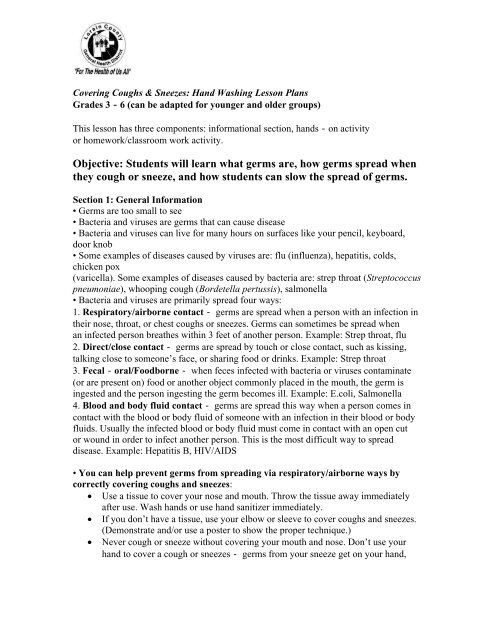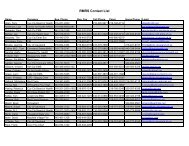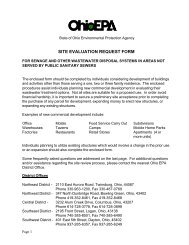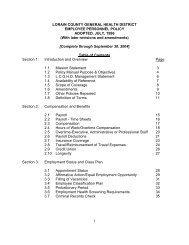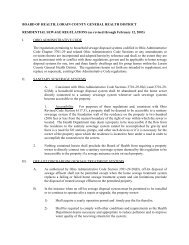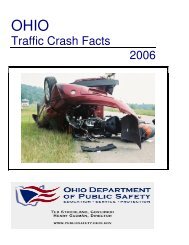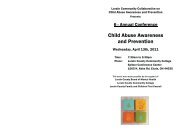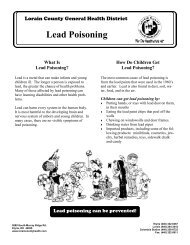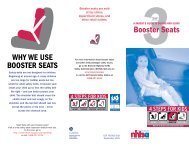Covering Coughs & Sneezes: Hand Washing Lesson Plans
Covering Coughs & Sneezes: Hand Washing Lesson Plans
Covering Coughs & Sneezes: Hand Washing Lesson Plans
Create successful ePaper yourself
Turn your PDF publications into a flip-book with our unique Google optimized e-Paper software.
<strong>Covering</strong> <strong>Coughs</strong> & <strong>Sneezes</strong>: <strong>Hand</strong> <strong>Washing</strong> <strong>Lesson</strong> <strong>Plans</strong><br />
Grades 3‐6 (can be adapted for younger and older groups)<br />
This lesson has three components: informational section, hands‐on activity<br />
or homework/classroom work activity.<br />
Objective: Students will learn what germs are, how germs spread when<br />
they cough or sneeze, and how students can slow the spread of germs.<br />
Section 1: General Information<br />
• Germs are too small to see<br />
• Bacteria and viruses are germs that can cause disease<br />
• Bacteria and viruses can live for many hours on surfaces like your pencil, keyboard,<br />
door knob<br />
• Some examples of diseases caused by viruses are: flu (influenza), hepatitis, colds,<br />
chicken pox<br />
(varicella). Some examples of diseases caused by bacteria are: strep throat (Streptococcus<br />
pneumoniae), whooping cough (Bordetella pertussis), salmonella<br />
• Bacteria and viruses are primarily spread four ways:<br />
1. Respiratory/airborne contact‐ germs are spread when a person with an infection in<br />
their nose, throat, or chest coughs or sneezes. Germs can sometimes be spread when<br />
an infected person breathes within 3 feet of another person. Example: Strep throat, flu<br />
2. Direct/close contact‐ germs are spread by touch or close contact, such as kissing,<br />
talking close to someone’s face, or sharing food or drinks. Example: Strep throat<br />
3. Fecal‐oral/Foodborne‐ when feces infected with bacteria or viruses contaminate<br />
(or are present on) food or another object commonly placed in the mouth, the germ is<br />
ingested and the person ingesting the germ becomes ill. Example: E.coli, Salmonella<br />
4. Blood and body fluid contact‐ germs are spread this way when a person comes in<br />
contact with the blood or body fluid of someone with an infection in their blood or body<br />
fluids. Usually the infected blood or body fluid must come in contact with an open cut<br />
or wound in order to infect another person. This is the most difficult way to spread<br />
disease. Example: Hepatitis B, HIV/AIDS<br />
• You can help prevent germs from spreading via respiratory/airborne ways by<br />
correctly covering coughs and sneezes:<br />
• Use a tissue to cover your nose and mouth. Throw the tissue away immediately<br />
after use. Wash hands or use hand sanitizer immediately.<br />
• If you don’t have a tissue, use your elbow or sleeve to cover coughs and sneezes.<br />
(Demonstrate and/or use a poster to show the proper technique.)<br />
• Never cough or sneeze without covering your mouth and nose. Don’t use your<br />
hand to cover a cough or sneezes‐ germs from your sneeze get on your hand,
then you touch your classmates pencil, your classmate touches the pencil, then<br />
rubs his eye, and now your germs are in his body.<br />
Section 2: “Mister” Sneeze Activity<br />
1) Fill a spray bottle with water (use colored water for special effect) and set the nozzle to<br />
“mist”.<br />
2) Explain to class that the water is like all the germs inside of each of them.<br />
3) Pretend to sneeze (don’t cover up sneeze), and as you do spray the water on the<br />
children sitting in front of you. Walk around the room and continue to pretend sneeze and<br />
cough while spraying water.<br />
4) Explain that this activity demonstrates how germs are spread when you don’t cover<br />
your cough or sneeze.<br />
5) Now, use a tissue to cover up a pretend sneeze/cough. Repeat, using your elbow or<br />
upper arm to cover the sneeze/cough.<br />
6) Explain that this activity demonstrates how germs are prevented from spreading by<br />
using the tissue or your elbow.<br />
From: Hummingbird Educational Resources,<br />
http://www.hummingbirded.com/personal‐hygiene.html<br />
Section 3: <strong>Hand</strong>s‐On Activity<br />
Peel two raw potatoes. Have students cough or sneeze into their hands and then touch one<br />
of the potatoes. Then, have students either wash their hands for 20 seconds, or use hand<br />
sanitizer. Now, have students cough or sneeze into their elbow, and then touch the second<br />
potato. Put both in clear containers and then observe/ record the differences. The potato<br />
that was touched by hands that had covered a cough or sneeze is supposed to turn<br />
disgusting very quickly.<br />
From: Hummingbird Educational Resources,<br />
http://www.hummingbirded.com/personal‐hygiene.html<br />
Other Resources<br />
ACTIVITY: Germy Puffs<br />
1) Explain that the class will be demonstrating what happens if they don’t cover their<br />
coughs/sneezes.<br />
2) Sprinkle small amount of baby powder on palm, then pretend to sneeze/cough while<br />
blowing the baby powder off your palm.<br />
3) Ask students: What happened to the powder How are germs like the powder<br />
4) Repeat step 2, but cover cough/sneeze with a tissue and then your elbow.<br />
5) Ask students: What happened to the powder now Did this slow the spread of germs<br />
Adapted from Science Surprises! Ready‐to‐Use Experiments & Activities for Young<br />
Learners by Jean R. Feldman, Ph.D<br />
©2000‐2007 Pearson Education, Inc. All Rights Reserved.
WEB SITES (geared toward preventing the spread of disease)<br />
http://www.johnson‐county.com/publichealth/infDisease/germFighters.shtml<br />
www.dettol.co.uk/kids.shtml<br />
www.bam.gov<br />
www.cdc.gov/germstopper/<br />
www.itsasnap.org<br />
www.stock2forflu.com<br />
http://www.metrokc.gov/health/stopgerms/learn/index.htm<br />
http://www.kidshealth.org/kid/


